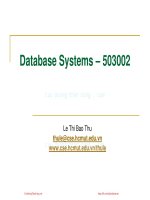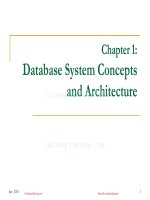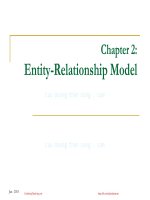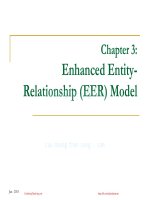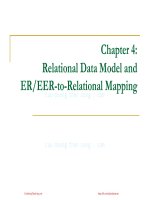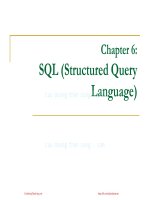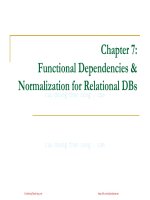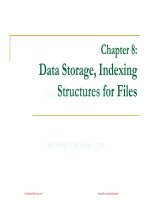cơ sở dữ liệu lê thị bảo thu chương ter 02 erd sinhvienzone com
Bạn đang xem bản rút gọn của tài liệu. Xem và tải ngay bản đầy đủ của tài liệu tại đây (1.99 MB, 70 trang )
Chapter 2:
Entity-Relationship Model
Jan - 2015
CuuDuongThanCong.com
/>
Contents
1
Overview of Database Design Process
2
What is ER Model? And Why?
3
A Sample Database Application
4
ER Model Concepts
5
ER Diagram and Naming Conventions
6
Alternative Diagrammatic Notations
7
Relationship Types of Degree Higher than Two
8
Problems with ER Models
Jan - 2015
CuuDuongThanCong.com
/>
Contents
1
Overview of Database Design Process
2
What is ER Model? And Why?
3
A Sample Database Application
4
ER Model Concepts
5
ER Diagram and Naming Conventions
6
Alternative Diagrammatic Notations
7
Relationship Types of Degree Higher than Two
8
Problems with ER Models
Jan - 2015
CuuDuongThanCong.com
/>
Overview of Database Design Process
Two main activities:
Focus in this chapter on database design
Database design
Applications design
To design the conceptual schema for a database
application
Applications design focuses on the programs
and interfaces that access the database
Jan - 2015
Generally considered part of software engineering
CuuDuongThanCong.com
/>
Overview of Database Design Process
Jan - 2015
CuuDuongThanCong.com
/>
Overview of Database Design Process
Requirements collection and analysis
Database designers interview prospective tuong lai
database users to understand and document data
requirements
Result:
Jan - 2015
Data requirements
Functional requirements
CuuDuongThanCong.com
/>
Overview of Database Design Process
Conceptual design
Create a conceptual schema for the database.
Jan - 2015
Description of data requirements
Uses the concepts provided by the high-level data
model
Includes detailed descriptions of the entity types,
relationships, and constraints
Independent of storage and implementation details.
CuuDuongThanCong.com
/>
Overview of Database Design Process
Logical design or data model mapping
Result is a database schema in implementation
data model of DBMS
Physical design phase
Jan - 2015
Internal storage structures, file organizations,
indexes, access paths, and physical design
parameters for the database files specified
CuuDuongThanCong.com
/>
Contents
1
Overview of Database Design Process
2
What is ER Model? And Why?
3
A Sample Database Application
4
ER Model Concepts
5
ER Diagram and Naming Conventions
6
Alternative Diagrammatic Notations
7
Relationship Types of Degree Higher than Two
8
Problems with ER Models
Jan - 2015
CuuDuongThanCong.com
/>
What is ER Model?
Entity-Relationship (ER) model
Popular high-level conceptual data model
A logical organisation of data within a database
system
ER diagrams:
Jan - 2015
Diagrammatic notation associated with the ER
model
CuuDuongThanCong.com
/>
Why use ER data modelling?
User requirements can be specified formally
& unambiguously khong mo ho
The conceptual data model is independent of
any particular DBMS
It does not involve any physical or
implemental details
It can be easily understood by ordinary users.
It provides an effective bridge between user
requirements and logical database design
and implementation
Jan - 2015
CuuDuongThanCong.com
/>
Contents
1
Overview of Database Design Process
2
What is ER Model? And Why?
3
A Sample Database Application
4
ER Model Concepts
5
ER Diagram and Naming Conventions
6
Alternative Diagrammatic Notations
7
Relationship Types of Degree Higher than Two
8
Problems with ER Models
Jan - 2015
CuuDuongThanCong.com
/>
A Sample Database Application
The COMPANY database: keeps track of
employees, departments, and projects.
The company is organized into DEPARTMENTs.
Each department has a unique name, a unique
number, and a particular employee who manages
the department. We keep track of the start date
when that employee began managing the
department. A department may have several
locations.
A department controls a number of PROJECTs,
each of which has a unique name, a unique number,
and a single location.
Jan - 2015
CuuDuongThanCong.com
/>
A Sample Database Application
Jan - 2015
We store EMPLOYEE’s name, Social Security
number, address, salary, sex, and birth date. An
employee is assigned to one department, but may
work on several projects, which are not necessarily
controlled by the same department. We keep track
of the current number of hours per week that an
employee works on each project. We also keep
track of the direct supervisor of each employee.
We want to keep track of the DEPENDENTs of
each employee, including first name, sex, birth
date, and relationship to the employee.
CuuDuongThanCong.com
/>
COMPANY Database
Jan - 2015
CuuDuongThanCong.com
/>
Contents
1
Overview of Database Design Process
2
What is ER Model? And Why?
3
A Sample Database Application
4
ER Model Concepts
5
ER Diagram and Naming Conventions
6
Alternative Diagrammatic Notations
7
Relationship Types of Degree Higher than Two
8
Problems with ER Models
Jan - 2015
CuuDuongThanCong.com
/>
ER Model Concepts
ER model describes data as:
Jan - 2015
Entities
Relationships
Attributes
CuuDuongThanCong.com
/>
Entities and Attributes
Entity is a thing in the real world with an
independent existence.
Attributes are properties described an entity.
Ex: the EMPLOYEE John Smith, the Research
DEPARTMENT, the ProductX PROJECT
Ex: an EMPLOYEE entity may have Name, SSN,
Address, Sex, BirthDate
A specific entity will have a value for each of its
attributes
Each attribute has a value set (or data type)
associated with it.
Jan - 2015
CuuDuongThanCong.com
/>
Entities and Attributes
Types of Attributes
Jan - 2015
Simple attributes: each entity has a single atomic
value for the attribute.
Composite attributes: attribute may be composed of
several components.
Multi-valued attributes: an entity may have multiple
values for that attribute.
Derived: attribute represents a value that is derivable
from value of a related attribute, or set of attributes.
Complex attributes: composite and multivalued
attributes can be nested arbitrarily
CuuDuongThanCong.com
/>
COMPANY Database
Jan - 2015
CuuDuongThanCong.com
/>
Entities and Attributes
Two entities, EMPLOYEE e1, and COMPANY
c1, and their attributes.
Jan - 2015
CuuDuongThanCong.com
/>
Entity Types and Keys
Entity type
Jan - 2015
Collection (or set) of entities that have the same
attributes
CuuDuongThanCong.com
/>
Entity Types and Keys
Key or uniqueness constraint
Attributes whose values are distinct for each
individual entity in entity set
Uniqueness property must hold for every entity set
of the entity type
Ex: SSN of EMPLOYEE
An entity type may have more than one key.
Ex: the STUDENT entity type may have two keys
(in university context):
Jan - 2015
Citizen ID and
Student ID
CuuDuongThanCong.com
/>
Entity Type CAR with two keys and a
corresponding Entity Set
Jan - 2015
CuuDuongThanCong.com
/>
Initial Conceptual Design of
COMPANY Database
Jan - 2015
CuuDuongThanCong.com
/>
